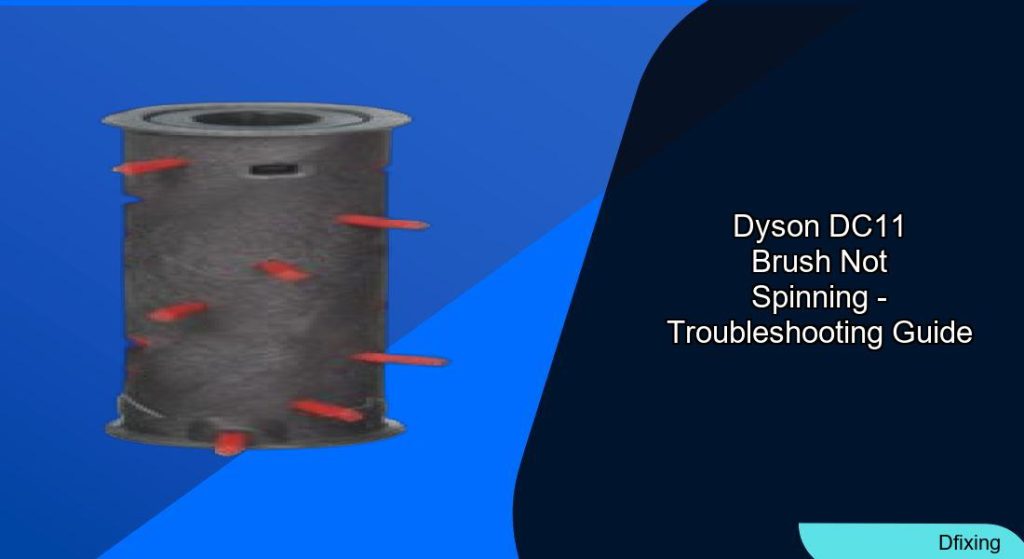A non-spinning brush bar on your Dyson DC11 can turn routine cleaning into a frustrating task. This issue often stems from debris buildup, mechanical wear, or electrical problems. Fortunately, most fixes are manageable with basic tools and a systematic approach. By following this guide, you’ll learn how to diagnose and resolve common causes, from tangled hair to motor malfunctions, and implement maintenance strategies to prevent future issues.
Affiliate disclosure: As an Amazon associate, We'll earn a commission for every successful order through our affiliate links in the article. However, you won’t be charged anything for this.
This article walks you through step-by-step solutions, including debris removal, belt replacement, motor troubleshooting, and advanced fixes for intermittent spinning or complete stoppage. Whether you’re dealing with a jammed brush roller or a faulty clutch, these methods will restore your vacuum’s performance. Let’s dive into the most frequent culprits and their remedies.
Identifying Common Causes of Dyson DC11 Brush Bar Issues
Debris Buildup and Mechanical Obstructions
Hair, dust, and debris Over time, this accumulation strains the motor and can damage the belt. Inspect the roller regularly for tangled material and clear obstructions using scissors or a blunt tool to avoid cuts.
Worn or Broken Belt
The belt connects the motor to the brush bar. If frayed, stretched, or snapped, the roller won’t spin. A damaged belt typically requires replacement. Check for visible cracks or slippage during inspections.
Motor or Clutch Malfunctions
If debris and the belt are ruled out, the problem may lie in the motor’s power delivery or the clutch mechanism. A faulty motor might emit unusual noises, while a worn clutch fails to engage the brush bar properly.
Step-by-Step Troubleshooting for DC11 Brush Issues
1. Clearing Debris from the Brush Roller
Turn off and unplug the vacuum. Remove the brush roller by pressing the release button or unscrewing the housing. Use scissors to cut away tangled hair, and gently pry out debris with a coin or flathead tool. Check the black spiral connector inside the brush head—ensure it rotates freely without the roller.
2. Replacing a Damaged Belt
Locate the belt inside the roller housing. If it’s cracked or broken, replace it with a compatible model. Align the new belt around the motor pulley and brush roller, ensuring even tension. Reassemble the housing securely.
3. Testing Motor and Clutch Functionality
Reconnect the belt and power on the vacuum. Observe if the roller spins. Listen for grinding or whining sounds, which signal motor wear. For clutch issues, manually engage the brush bar by pushing it into the motor unit until it clicks.
4. Inspecting Electrical Connections
Check wires for looseness or damage. Clean electrical pins at the brush head’s base using a dry cloth. For models with a reset button (e.g., DC41), unplug the vacuum, wait 5 minutes, then reset by toggling the power switch five times while the beater bar is extended.
Specific Problem Solutions
Intermittent Spinning
Symptoms: The brush bar spins briefly, then stops.
Fixes:
1. Deep-clean internal components, focusing on the motor/pulley assembly.
2. If the brush works upside down but stalls when upright, replace the motor/pulley assembly.
If the motor pulley assembly is damaged or worn, replacing it can resolve intermittent spinning issues.
Search term for Amazon: Dyson DC11 motor assembly
Complete Stoppage
Symptoms: No brush bar movement.
Fixes:
1. Check for blockages in the hose or dust canister. Use a flashlight or air pressure test to locate obstructions.
2. Reset the brush button as described above.
DC11 Model Beater Bar Reset
Extend the beater bar fully. Hold the power button and toggle the on/off switch five times while the bar is extended leftward. This resets mechanical faults.
Preventative Maintenance Tips
Regular Cleaning
Schedule monthly roller cleanings. Remove hair and debris with scissors or a brush. Clean filters and hoses every 3–6 months to maintain airflow.
Lubrication
Apply a silicone-based lubricant to the roller shaft. Avoid WD-40, as it attracts dust. Rotate the bar manually to distribute evenly, then wipe excess.
Storage and Handling
Store the vacuum in a dry area. Avoid bending the brush bar or overloading the canister with large debris to prevent motor strain.
Frequently Asked Questions (FAQ)
How often should I clean the Dyson DC11 brush roller?
At least once a month, or more frequently in households with pets or long hair.
What signs indicate a faulty motor?
Unusual noises (grinding, whining), overheating, or lack of brush bar movement despite a functional belt.
Can I use WD-40 to lubricate the brush bar?
No—WD-40 attracts dust. Use silicone spray instead for smooth operation without residue buildup.
How do I reset the brush bar on a Dyson DC41?
Extend the beater bar fully, hold the power button, and toggle the on/off switch five times while the bar is extended leftward.
Conclusion
A Dyson DC11 brush bar that won’t spin is often fixable with basic maintenance and troubleshooting. By addressing debris buildup, replacing worn belts, and inspecting electrical or mechanical components, you can restore optimal performance. Regular cleaning and proper storage prevent recurring issues, while model-specific resets (like the DC41 method) offer quick fixes for stubborn faults.
If motor or clutch damage persists, replacement parts are available through Dyson’s official channels. Implement these strategies to keep your vacuum running smoothly and extend its lifespan.







